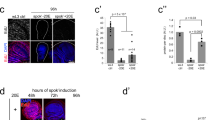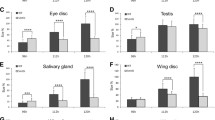Summary
We have investigated the action of the moulting hormone 20-hydroxy ecdysone (20-HOE) on our leg and wing imaginal disc cell lines. At the morphological level, cells stop dividing and there is some cell death. The remaining cells elongate and aggregate, often producing long processes which form connections between different aggregates. 20-HOE acts within the first one or two days of a passage, at an optimum concentration of 10 ng/ml, this being about 1/100 of the optimum for ecdysone. One cloned wing cell line, C9, has been found to be relatively insensitive to the action of 20-HOE. We have been able to select for resistance to 20-HOE by growing cells in gradually increasing concentrations of hormone followed by passages in hormone-free medium. This has enabled us to isolate a wing cell line C1.8R from its parent cloned line C1.8+. This shows no response to 20-HOE, and cell growth continues even at hormone concentrations as high as 150 ng/ml. We have measured chitin synthesis by the incorporation of radioactive glucosamine into a cell fraction resistant to extensive alkali hydrolysis. The residue was incubated with chitinase, which resulted in a 50% reduction in labelled product. Treatment with 10 ng/ml of 20-HOE dramatically increased chitin synthesis in line C1.8+, but had no effect in the line C1.8R, selected for resistance to hormone.
Similar content being viewed by others
References
Berger E, Frank M, Abell M (1980) Eedysone-induced changes in protein synthesis in embryonic Drosophila cells in culture. In: Kurstak E, Maramorosch K, Dübendorfer A (eds). Invertebrate systems in vitro. Elsevier/North Holland Biomedical Press, pp 195–217
Bradford MM (1976) A rapid and sensitive method for quantitation of microgram quantities of protein utilising the principle of protein-dye binding. Anal Biochem 72:248–254
Cassier P, Serrant P, Garcia R, Coudouel N, Andre M, Guillaumin D, Porcheron P, Oberlander H (1991) Morphological and cytochemical studies of the effects of ecdysteroids in a lepidopteran cell line (IAL-PID2). Cell Tissue Res 265:361–369
Cherbas L, Cherbas P (1981) The effects of ecdysteroid hormones on Drosophila melanogaster cell lines. In: Maramorosch K (ed). Advances in cell culture, vol. 1. Academic Press, London, New York, pp 91–124
Cherbas L, Yonge CD, Cherbas P, Williams C (1980) The morphological response of Kc-H cells to ecdysteroids: hormonal specificity. Roux's Arch Dev Biol 189:1–15
Condic ML, Fristrom D, Fristrom JW (1991) Apical cell shape changes during Drosophila imaginal leg disc elongation: a novel morphogenetic mechanism. Development 111:23–33
Courgeon AM (1972) Action of insect hormones at the cellular level: morphological changes of a diploid cell line of Drosophila melanogaster treated with ecdysone and several analogues in vitro. Exp Cell Res 74:327–336
Cullen CF, Milner MJ (1991) Parameters of growth in primary cultures and cell lines established from Drosophila imaginal discs. Tissue Cell 23:29–39
Currie DA, Milner MJ, Evans CW (1988) The growth and differentiation in vitro of leg and wing imaginal disc cells from Drosophila melanogaster. Development 102:805–814
Delhanty P, Locke M (1989) The development of epidermal feet in preparation for metamorphosis in an insect. Tissue Cell 21:891–909
Echalier G, Ohanessian A (1970) In vitro culture of Drosophila melanogaster embryonic cells. In Vitro 6:162–172
Fristrom JW, Doctor J, Fristrom DK, Logan WR, Silvert DJ (1982) The formation of the pupal cuticle by Drosophila imaginal discs in vitro. Dev Biol 91:337–350
Locke M (1981) Cell structure during insect metamorphosis. In: Gilbert L, Frieden E (eds). Metamorphosis: a problem in biology. Plenum Press, Oxford, pp 75–104
Locke M, Huie P (1981) Epidermal feet in pupal segment morphogenesis. Tissue Cell 13:787–803
Londerhausen M, Kammann V, Spindler-Barth M, Spindler K-D, Thomas H (1988) Chitin synthesis in insect cell lines. Insect Biochem 18:631–636
Marks EP, Ward GB (1987) Cell culture techniques for studying insect cuticle. Arch Insect Biochem Physiol 6:217–225
Milner MJ (1992) Drosophila cell and tissue culture. In: Griffiths JB, Doyle A, Nwell DG (eds). Protocols in cell and tissue culture. John Wiley (in press)
Milner MJ, Bleasby AJ, Pyott A (1983) The role of the peripodial membrane in the morphogenesis of the eye-antennal disc of Drosophila melanogaster. Roux's Arch Dev Biol 192:164–170
Milner MJ, Sang JH (1974) Relative effects of α-ecdysone and β-ecdysone for the differentiation in vitro of Drosophila melanogaster imaginal discs. Cell 3:141–143
Oberlander H, Ferkovich SM, Van Essen F, Leach CE (1978) Chitin biosynthesis in imaginal discs cultured in vitro. Roux's Arch Dev Biol 185:95–98
Peel DJ, Johnson SA, Milner MJ (1990) The ultrastructure of imaginal disc cells in primary cultures and during cell aggregation in continuous cell lines. Tissue Cell 22:749–758
Peel DJ, Milner MJ (1990) The diversity of cell morphology in cloned cell lines derived from Drosophila imaginal discs. Roux's Arch Dev Biol 198:479–482
Rosset R (1978) Effects of ecdysone on a Drosophila cell line. Exp Cell Res 111:31–36
Sang JH (1981) In: Maramorosch K (ed) Drosophila cells and cell lines. Advances in cell culture, vol. 1. Academic Press, London, New York, pp 125–182
Schneider I (1972) Cell lines derived from late embryonic stages of Drosophila melanogaster. J Embryol Exp Morphol 27:353–365
Spreij TE (1971) Cell death during the development of the imaginal discs of Calliphora erythrocephala. Neth J Zool 3:221–264
Stephens B, Alvarez CM, Bohman R, O'Connor JD (1980) An ecdysteroid-induced alteration in the cell cycle of cultured Drosophila cells. Cell 22:675–682
Ward GB, Newman SM, Klosterman HJ, Marks EP (1988) Effect of 20-hydroxy ecdysone and diflubenzuron on chitin production by a cockroach cell line. In Vitro 24:326–332
Wolff T, Ready DF (1991) Cell death in normal and rough eye mutants of Drosophila. Development 113:825–839
Wyss C (1976) Juvenile hormone analogue counteracts growth stimulation and inhibition by ecdysone in clonal Drosophila cell lines. Experientia 32:1272–1274
Wyss C (1982) Chironomus tentans epithelial cell lines sensitive to ecdysteroids, juvenile hormone, insulin and heat shock. Exp Cell Res 139:309–319
Author information
Authors and Affiliations
Additional information
Correspondence to: M.J. Milner
Rights and permissions
About this article
Cite this article
Peel, D.J., Milner, M.J. The response of Drosophila imaginal disc cell lines to ecdysteroids. Roux's Arch Dev Biol 202, 23–35 (1992). https://doi.org/10.1007/BF00364594
Received:
Accepted:
Issue Date:
DOI: https://doi.org/10.1007/BF00364594




